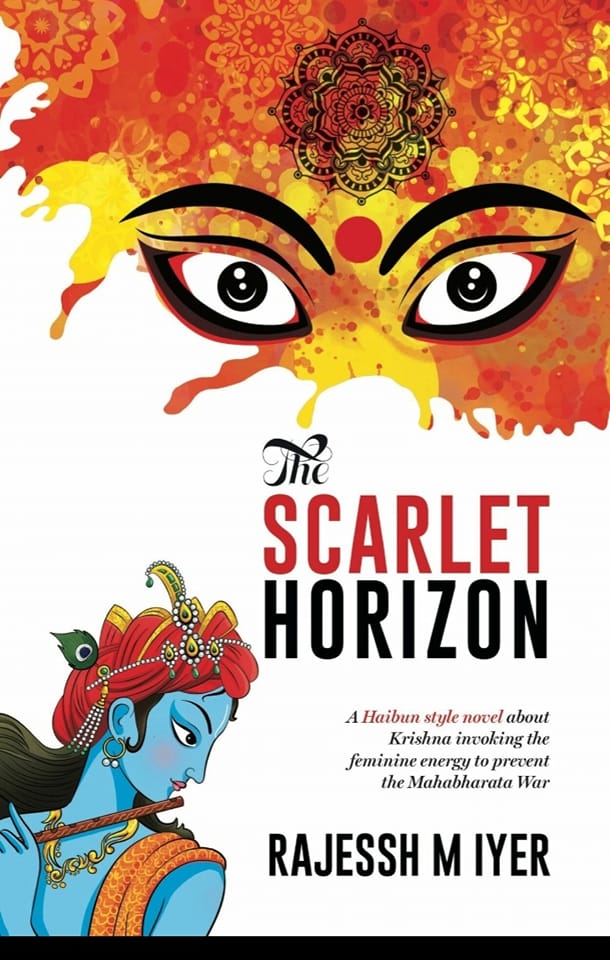
The story of The Mahabharata has lured many a writer to take fresh perspectives on. It is a tale of our ancestors that has never ceased to fascinate us. There are events that could entice a creative mind and she/he could take giant leaps of imagination either through prose, poetry, or any other creative or performance art forms. Yet, The Mahabharata remains untouched – a catalyst that transforms generations through its narration. In fact, it is these viewpoints through which the seeker tries to fathom this odyssey, trying to get a glimpse of its soul!
My curiosity was piqued when I first heard about the Haibun-style novel about Krishna invoking the feminine energies – the Dasa Mahavidya, to prevent the Mahabharata war! I was floored by the salutations at the start of the book itself. Expressing gratitude to the “Holy Arbiter” ie; Shani (Saturn) was a rare acknowledgment. And I salute the author for doing that. Inside it was pure joy for all who love the thrill of a period drama, with all its nerve-wracking plots and subplots. Apart from the most popular actors of the grand epic, the normal reader (and not the student) of The Mahabharata is bereft of the existence of other powerful and complex characters who hold their own ground and give pivotal experiences. This book opens the reader’s vision toward those. It is a fresh take on keeping women as the central character of the storyline which is primarily based on the backdrop of a patriarchal society. While the men may fight the Holy War, it would be the women who would be facing the brunt of the war. After several failed attempts in getting the promised land back for the Pandavas and the eventual war, Krishna turns to the women who would be most affected by the war – Duryodhan’s daughter who was Krishna’s daughter-in-law, Queen Mother Gandhari, Draupadi – the Empress in waiting, Kunti – the mother of the Pandavas, Duryodhan’s wife, wise man Vidur’s wife, the tragic widow of Abhimanyu (everyone knew what would be Uttara’s fate, right from when Abhimanyu was in the womb of Subhadra), Kripi and Shakuni & Karna’s wife! All their men (in the role of husbands, fathers, or brothers) had the power to stop the fateful war as each embodied a latent energy in each of them, which was only visible to the divine being, who had to take sides. Yet they couldn’t / didn’t. Was it because fate wanted it otherwise? It reminds me of one of the events in Mahabharata when the severed head of Barbarik was asked, as to what it saw from its high-ground viewpoint. And he is believed to have said, “Just the Sudarshan Chakra and the destructive dance of Goddess Kali!”
Though the feminine viewpoint has taken precedence over many things and it is the most popular le récit in current times, I was happily surprised that the author did not stride the beaten path. Having said that, I would have liked the story to be a tad meandering rather than the tight pace that the author has kept throughout. It is the bane of recent times, especially for a quick read and for mass appeal. This story could take the liberty of being a bit slow so that the reader could reflect on each of the characters and the windows that open to the introduction of the 10 great wisdoms. The Shakta cultural influence is evident, which makes it breathtakingly fresh (my curiosity is now further piqued to understand from the author, how he has deep-dived into a rather remote subject).
In Bengal, near Birbhum, there is a beautiful temple within the temple precincts of the grand Tarapith. It is the temple of KaliKrishna. A deity who has yet not caught the imagination of the masses. It is said that the Goddess Kali, wanted to come to the world and experience “rasa” and therefore comes in the form of Krishna. It is a rare form and some cults of Shakti Sadhakas worship this form. When the Dasa Mahavidya and the divine feminine, therefore, take center stage instead of the main Hero of the Mahabharata – Sri Krishna, in Rajessh Iyer’s narrative, I doubt the Purushottama (read Krishna) would have any issues.